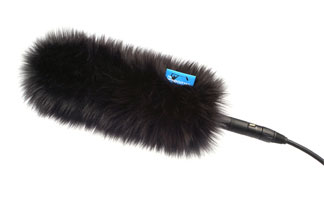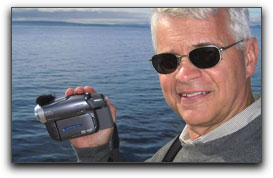
May 3, 2010
for Wind Noise & Stick On WindCutters
For consumer level camcorders
http://www.thewindcutter.com
StormChaser-$43.95 - Stick On-$14.95
Review by Steve Douglas
You've lugged your tripod, lighting stands and lights, reflectors, props, microphones, boom poles and accessories outdoors to shoot that romantic scene in the park. You've set it all up, your video cam is mounted and focused, your actors are ready and on their marks. You shoot multiple takes of the scene just to be sure you caught everything right. Viola, an excellent day and all went well. You're at the editing bay and have just ingested all the footage you needed. Now to sit back and watch which takes you decide upon. Ouch! That breeze you thought was slight comes across in the audio loud and clear, it sounds as if there was gust after gust.
This scenario has been repeated in one form or another many times wrecking havoc during postproduction. Many videographers using shotgun mics have made the mistake in thinking that the foam wind protector that came with the microphone at purchase would eliminate unwanted wind noise. The same situation applies to those using a consumer camcorder's on-board microphone. Though shotgun microphones are usually directional, they still have varying pickup patterns, while on- board microphones tend to be omni-directional and sensitive to sound independent from where the camcorder is aimed.
While the supplied foam windscreen that comes with many shotgun microphones is just fine for indoor use where air movement is minimal, when shooting outdoor scenes or interviews, considerably more attention must be paid to blocking unwanted wind noise from interfering.
Fortunately there is an easy and inexpensive fix for this problem. From TheWindCutter.com comes a large variety of both foam and fur windscreens for any microphone you may have, as well as their new windscreens designed to attach to smaller consumer camcorder's built in microphones.

In order to choose just the right WindCutter for the microphone you use, just go on their website, look up the brand of microphone you are using, and choose the exact model number for the microphone you use. Don't see your specific model? Contact them and custom orders are readily filled. The WindCutter fur windscreens are designed to fit over the standard issue foam windscreen to provide as much protection against wind noise as possible. There are two basic types produced by WindCutter, the Standard WindCutter which is made from synthetic hair, is both pliable and soft and which lessens and dampens the amount of wind noise that can get through, providing clean audio tracks. The Standard WindCutter uses 1-inch length hairs and is advertised as being effective when recording in a mild wind. The model that's most effective in strong wind is their aptly named StormChaser model of windscreen. This model utilizes a longer, denser, 2-inch fiber. The StormChaser is the one I tested using an Azden SGM-1X microphone and is available in black, grey or white.
Fortunately, we have been having several rains and storms in San Diego, which provided excellent opportunities to get audio samples filming with plenty of wind noise. During the tests I took audio samples with the microphone uncovered, using just foam, and using both the original foam plus the StormChaser WindCutter There was not a whole lot of difference between using the microphone uncovered as well as with its accompanying foam protector. Basically, the audio samples would have been un-usable if they had been needed for a project. However, when using the WindCutter's StormChaser there was a world of difference and it was very positive. Had I needed this footage for a project, I easily could have used what I recorded using the WindCutter.

For those restricted to using their camcorder's on-board microphones The WindCutter has come out with the Stick-On version as well. I tested these on a Sony A1-U after removing the XLR microphone and reverting to the camcorder's on-board mic. For those with a double mic area with more than 1/2" of space between the two mic areas, the cost goes up from $14.95 to $23.95, still a good price. You simply make sure the mic area is nice and clean, peel off the backing material of the WindCutter and align it upon the sound holes of your camcorder's microphone. This type of WindCutter is not meant to be removable, so once it is on, it is on. You could peel it off if you wanted to but I can see no reason for it. The hairs look to be about 1 inch and, again, in a wind noise comparison, they did a very credible job of reducing unwanted wind noise.
The bottom line is that protecting your audio is equally as important as making sure your video is properly exposed. Why spend costly hours of unnecessary attempts to correct for poorly captured audio in post production, when for the very small price of a WindCutter, you can capture it correctly the first time?

Steve Douglas is a certified Apple Pro for Final Cut Pro 7 and underwater videographer. A winner of the 1999 Pacific Coast Underwater Film Competition, 2003 IVIE competition, 2004 Los Angeles Underwater Photographic competition, and the prestigious 2005 International Beneath the Sea Film Competition, where he also won the Stan Waterman Award for Excellence in Underwater Videography and 'Diver of the Year', Steve was a safety diver on the feature film "The Deep Blue Sea", contributed footage to the Seaworld Park's Atlantis production, and productions for National Geographic and the History channels. Steve was a feature writer for Asian Diver Magazine and is one of the founding organizers of the San Diego UnderSea Film Exhibition. He is available for both private and group seminars for Final Cut Pro and leads underwater filming expeditions and African safaris with upcoming excursions to the Cocos Islands, Costa Rica, Lembeh Straits, Indonesia, and Wakatobi. Feel free to contact him if you are interested in joining Steve on any of these exciting trips. www.worldfilmsandtravel.com
[Top]
copyright © Steve Douglas 2010
are either registered trademarks or trademarks of Apple. Other company and product names may be trademarks of their respective owners.
All screen captures, images, and textual references are the property and trademark of their creators/owners/publishers.